Good nutrition is paramount to ensuring our feline companions live long, healthy lives. As responsible cat owners, we constantly seek ways to enhance their diet beyond the typical cat food. You might wonder, “Can vegetables play a beneficial role in my cat’s diet?” The answer is yes, but with nuances. Let’s delve into the world of vegetables and discover What Vegetables Can Cats Eat safely and beneficially.
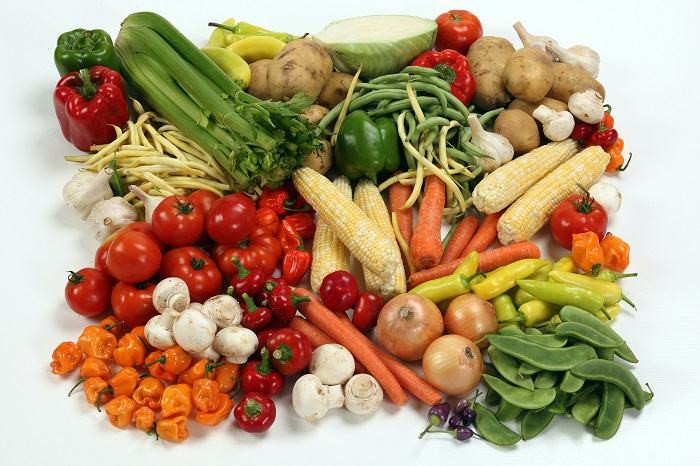 Various colorful vegetables including broccoli, carrots, and green beans are displayed, representing healthy and feline-friendly food options.
Various colorful vegetables including broccoli, carrots, and green beans are displayed, representing healthy and feline-friendly food options.
Can Cats Eat Vegetables? The Short Answer
Yes, cats can eat some vegetables in moderation. While cats are obligate carnivores and their primary nutritional needs are met by meat-based diets, certain vegetables can be a safe and even healthy supplement. Think of vegetables as occasional treats or additions to their meals rather than dietary staples.
However, it’s crucial to understand that not all vegetables are safe for cats. Some, like onions and garlic, are toxic and can cause serious health issues. Therefore, knowing what vegetables are safe for cats and which to avoid is essential for every cat owner.
Key Takeaway: Vegetables should never replace meat in a cat’s diet. Their nutritional foundation must always be meat-based to fulfill their obligate carnivore needs. Always consult with your veterinarian before introducing any new foods, including vegetables, to your cat’s diet.
Safe Vegetables For Cats: A Nutritious Selection
When considering safe vegetables for cats, think of options that are easily digestible and offer some nutritional value without being toxic. Here are some excellent choices:
1. Broccoli: A Fiber-Rich Treat
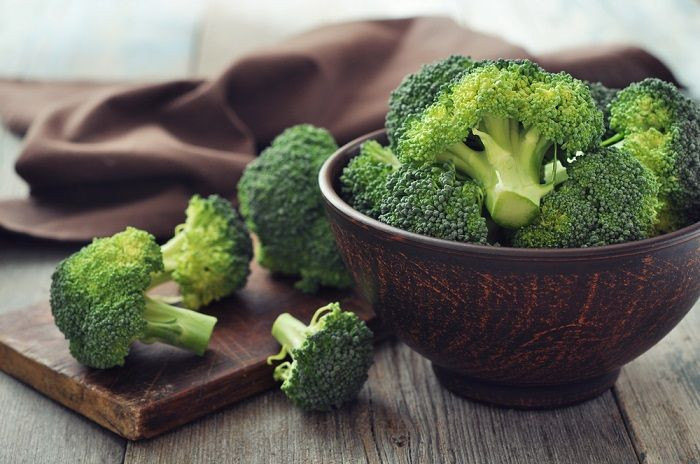 A close-up of fresh green broccoli florets, showcasing a healthy and fibrous vegetable option suitable for cats in moderation.
A close-up of fresh green broccoli florets, showcasing a healthy and fibrous vegetable option suitable for cats in moderation.
Broccoli is not only a safe vegetable for cats but also a nutritious one. Easy to prepare by steaming or boiling, broccoli provides antioxidants and is a good source of roughage. This fiber content can aid in digestion and promote healthy bowel movements in cats, contributing to a healthy digestive system.
2. Carrots: Vitamin A Boost
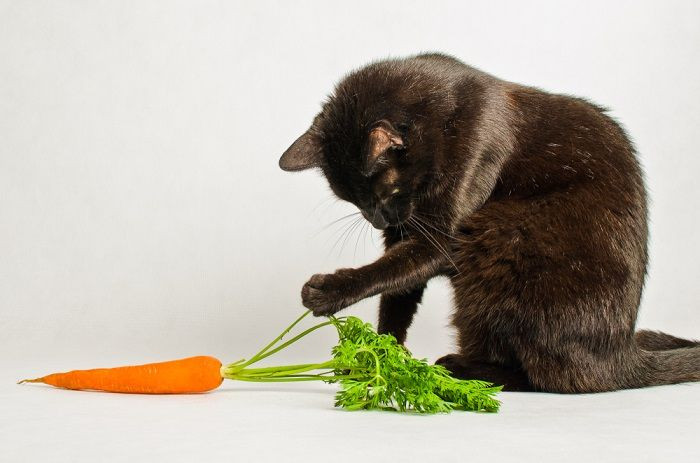 A ginger cat playfully interacts with a bright orange carrot, highlighting carrots as a source of Vitamin A and a safe vegetable for feline consumption.
A ginger cat playfully interacts with a bright orange carrot, highlighting carrots as a source of Vitamin A and a safe vegetable for feline consumption.
Carrots are another excellent vegetable choice, packed with vitamins and minerals, particularly Vitamin A. Vitamin A is crucial for maintaining good vision, a healthy immune system, and skin health in cats. Carrots can be offered cooked or raw, but cooking them softens them and reduces the choking hazard. However, moderation is key, especially for cats prone to calcium oxalate bladder stones due to the moderate oxalate content in carrots.
Read More: Can Cats Eat Carrots? for a deeper dive into the benefits and precautions.
3. Green Beans: Digestive Aid and Weight Management
 A pile of fresh green beans, illustrating a fiber-rich and low-sodium vegetable option that can aid in feline digestion and weight control.
A pile of fresh green beans, illustrating a fiber-rich and low-sodium vegetable option that can aid in feline digestion and weight control.
Green vegetables, in general, are often safe and beneficial for cats, including peas and, notably, green beans. Fresh, frozen (cooked), or even low-sodium canned green beans can be healthy additions. Green beans stand out due to their fiber content, which supports digestive health and can be helpful in weight management for cats. Like carrots, green beans contain moderate oxalates, so portion control is important, especially for cats with urinary issues.
4. Spinach: Anti-Inflammatory Benefits
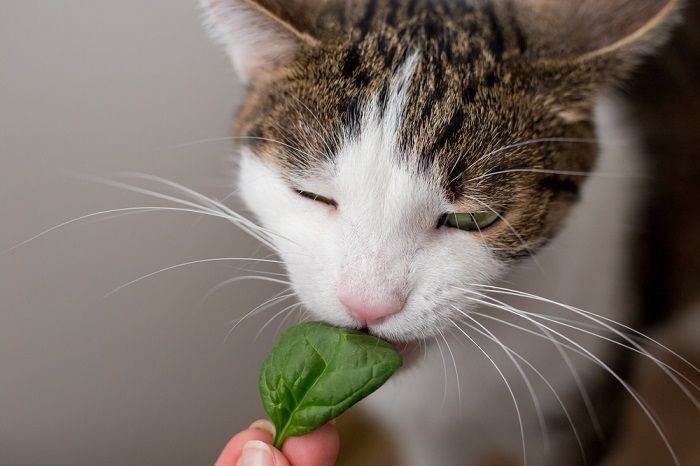 A cat curiously sniffs a pile of fresh spinach leaves, representing a vegetable with anti-inflammatory properties that can be beneficial for feline health in small quantities.
A cat curiously sniffs a pile of fresh spinach leaves, representing a vegetable with anti-inflammatory properties that can be beneficial for feline health in small quantities.
Spinach offers vitamins and minerals, and uniquely, it may have anti-inflammatory effects in cats. However, spinach must be given sparingly because of its calcium oxalate content. While small amounts are generally harmless, larger quantities can contribute to urinary tract problems. Moderation is particularly crucial with spinach.
5. Apples (Without Seeds or Core): Digestible Fruit Option
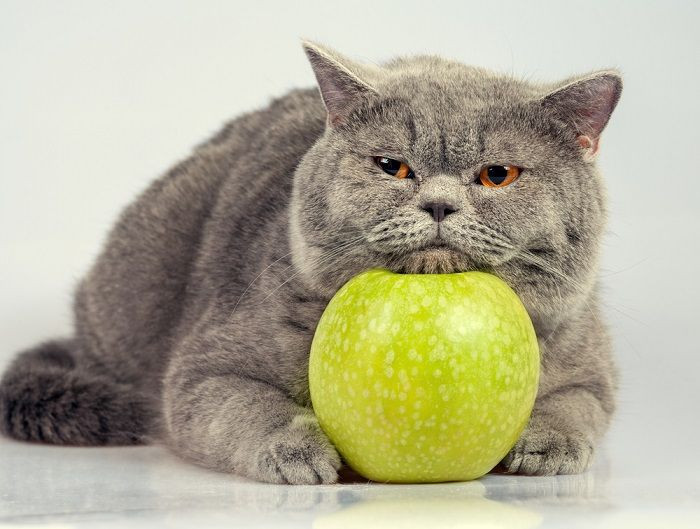 A cat sits beside a sliced red apple, emphasizing that apples are a safe fruit option for cats to eat in moderation and without the seeds or core.
A cat sits beside a sliced red apple, emphasizing that apples are a safe fruit option for cats to eat in moderation and without the seeds or core.
While technically a fruit, apples are often grouped with vegetables in dietary discussions and are safe for cats in moderation. Cats can eat apples and digest them, despite the myth that obligate carnivores cannot process plant-based foods. “Obligate carnivore” simply means they need meat for essential nutrients, not that they can’t digest anything else. Apples should be given without seeds and core, and in small amounts as treats. They are not suitable for diabetic cats due to their sugar content and should be introduced cautiously to cats with sensitive stomachs or IBD as the fiber can sometimes cause digestive upset.
Potential Downsides of Feeding Cats Vegetables
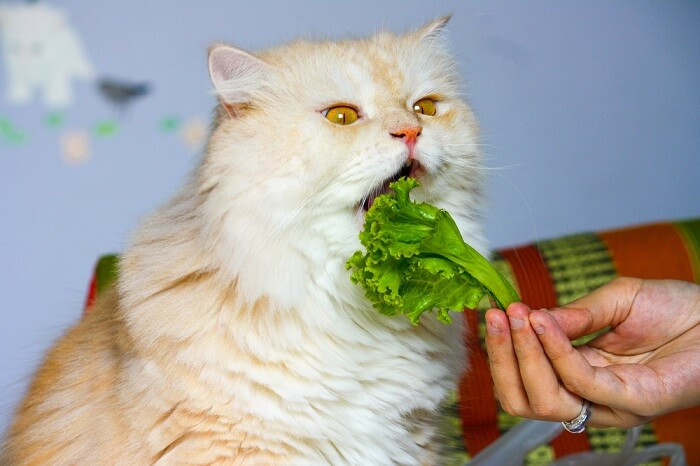 A tabby cat curiously chews on a piece of green lettuce, illustrating that while some vegetables are safe, moderation is key to avoid digestive issues in felines.
A tabby cat curiously chews on a piece of green lettuce, illustrating that while some vegetables are safe, moderation is key to avoid digestive issues in felines.
While some vegetables are safe and even beneficial, there are potential downsides to consider when feeding vegetables to cats. These primarily arise from overfeeding or choosing the wrong types of vegetables.
As obligate carnivores, cats have digestive systems optimized for meat. They lack specific digestive enzymes needed to efficiently break down large amounts of plant fiber. Too many vegetables can lead to digestive upset, including gas, bloating, and diarrhea.
Vegetables also contain carbohydrates. While some fiber is beneficial, excessive carbohydrates can contribute to feline obesity, a prevalent health issue. Therefore, even with safe vegetables, portion control is vital. Vegetables should always be supplementary and given in small amounts.
Furthermore, some vegetables are inherently toxic to cats, regardless of the quantity. Knowing which vegetables to avoid is as important as knowing which are safe.
Vegetables To Avoid: Toxic Veggies for Felines
Certain vegetables are strictly off-limits for cats due to their toxicity or difficulty in digestion. Here are some key vegetables to never feed your cat:
1. Onions, Chives, Garlic, and Leeks: The Allium Family Danger
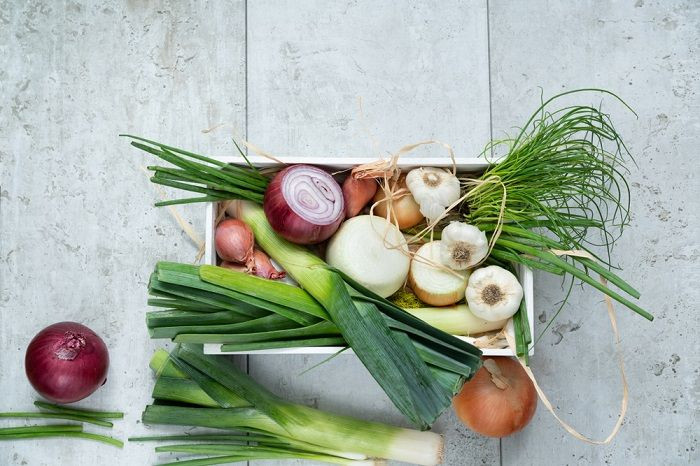 A collection of onions, chives, and garlic bulbs, clearly marked as toxic vegetables that should be avoided in a cat's diet due to their harmful compounds.
A collection of onions, chives, and garlic bulbs, clearly marked as toxic vegetables that should be avoided in a cat's diet due to their harmful compounds.
Members of the Allium genus, including onions, chives, garlic, and leeks, are highly toxic to cats. These vegetables contain sulfur-containing oxidants that cats cannot break down effectively. These compounds damage red blood cells, leading to hemolytic anemia.
Toxicity from these vegetables can occur in any form – raw, cooked, or powdered. Even small amounts can be harmful. Garlic is particularly potent in this group. Symptoms of Allium toxicity include vomiting, diarrhea, lethargy, labored breathing, pale gums, and reddish or brownish urine. Immediate veterinary attention is needed if you suspect your cat has ingested any of these vegetables.
2. Tomatoes (Green Parts): Solanine Toxicity
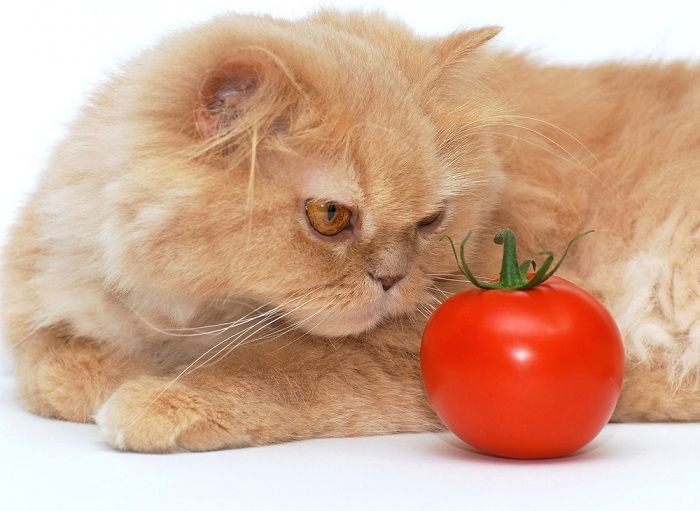 A cat near a ripe red tomato, with a warning that while ripe tomatoes are generally safe, green parts and unripe tomatoes can be toxic to cats.
A cat near a ripe red tomato, with a warning that while ripe tomatoes are generally safe, green parts and unripe tomatoes can be toxic to cats.
Ripe tomatoes themselves are generally considered safe for cats in small amounts. However, the green parts of the tomato plant, such as leaves, stems, and unripe tomatoes, contain solanine, which is toxic to cats. Ingestion of these parts can cause gastrointestinal upset and other symptoms. It’s best to avoid giving cats any part of the tomato plant other than a very small piece of ripe fruit, and even then, it offers little nutritional benefit.
3. Avocados: High Fat and Persin Concerns
 A sliced avocado next to a cat, illustrating that avocados are not recommended for cats due to their high fat content and the presence of persin, which can be harmful.
A sliced avocado next to a cat, illustrating that avocados are not recommended for cats due to their high fat content and the presence of persin, which can be harmful.
Avocados are popular for human consumption but are not suitable for cats. They have a very high fat content, which can cause digestive upset and potentially pancreatitis in cats. Furthermore, avocados contain persin, a fungicidal toxin that can be harmful to cats in large quantities. While the level of persin in the edible part of avocado is generally low, it’s best to avoid avocados altogether for your feline friend.
Read More: Pancreatitis in Cats: Causes, Symptoms, & Treatment to understand the risks of high-fat foods.
Benefits Of Vegetables For Cats: Nutritional Perks
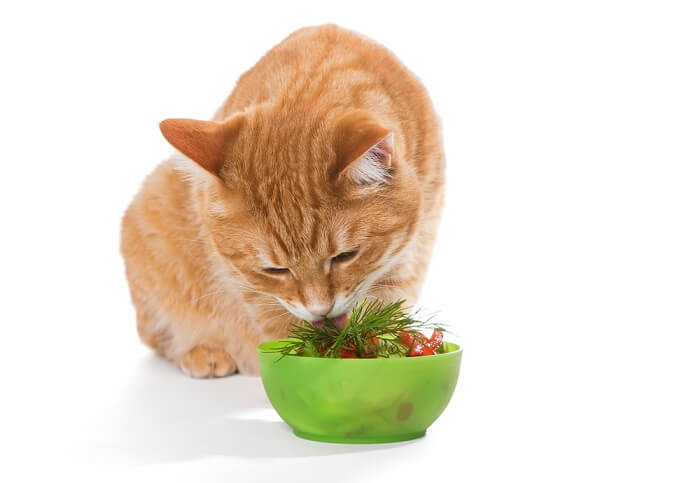 A cat happily eats a salad in a bowl, suggesting that vegetables can provide some nutritional benefits to cats when included as a supplement to their diet.
A cat happily eats a salad in a bowl, suggesting that vegetables can provide some nutritional benefits to cats when included as a supplement to their diet.
While not essential, vegetables can offer some nutritional benefits when given as a supplement to a cat’s primarily meat-based diet. Safe vegetables for cats can provide:
- Vitamins and Minerals: Vegetables contain various vitamins (like Vitamin A from carrots) and minerals (like potassium and magnesium) that can contribute to overall health.
- Fiber: Fiber from vegetables aids in digestion, promotes regular bowel movements, and can assist with weight management.
- Antioxidants: Vegetables like broccoli and spinach contain antioxidants that help combat cell damage and support the immune system.
- Variety: Vegetables can add variety to a cat’s diet, especially for picky eaters, and can be used as low-calorie treats in place of commercial cat treats.
Remember, vegetables should only constitute a small percentage (ideally under 10%) of a cat’s daily calorie intake. Always consult your veterinarian before making significant changes to your cat’s diet or introducing vegetables, especially if your cat has any underlying health conditions.
Conclusion: Vegetables as Occasional Treats, Not Staples
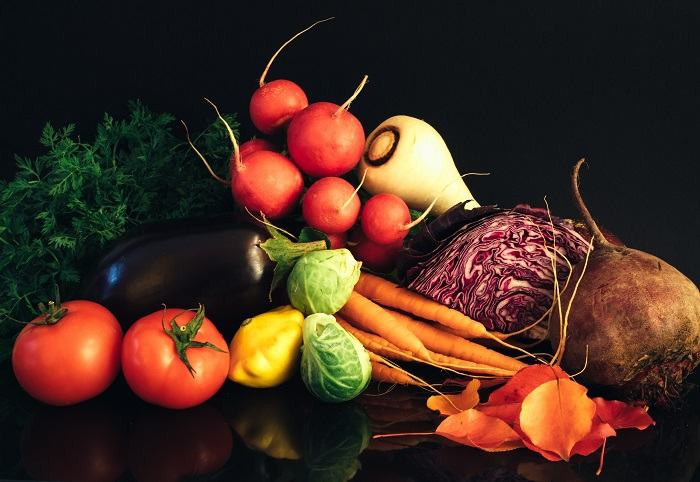 A variety of colorful and cooked vegetables in a bowl, summarizing that vegetables are safe for cats as occasional treats and not as a primary food source.
A variety of colorful and cooked vegetables in a bowl, summarizing that vegetables are safe for cats as occasional treats and not as a primary food source.
In summary, cats can eat some vegetables safely and may even derive some nutritional benefits. However, vegetables should always be given as occasional treats and never form the core of a cat’s diet. Prioritize safe vegetables for cats like broccoli, carrots, green beans, spinach, and apples (without seeds or core) in moderation.
Always avoid toxic vegetables such as onions, garlic, chives, leeks, green tomatoes, and avocados. Observe your cat for any signs of digestive upset after introducing new vegetables and consult your veterinarian if you have any concerns or questions about what vegetables can cats eat or how to incorporate them into your cat’s diet safely.
Frequently Asked Questions About Cats and Vegetables
How much vegetable can I give my cat?
When offering vegetables to your cat, preparation is key. Bake or steam them until soft and cut them into small, manageable pieces to prevent choking hazards. You can offer them as standalone treats or mix pureed vegetables into their regular food. Vegetables and treats combined should not exceed 10% of your cat’s daily calorie intake, with the remaining 90% coming from high-quality cat food.
Are vegetables good for cats?
While cats don’t require vegetables, many are safe for them to eat and can offer some nutritional value in small quantities. Vegetables should not be considered a major part of their diet. A balanced, high-quality cat food is essential to provide all the necessary nutrients for optimal feline health. Vegetables are supplemental at best.
Can cats eat vegetables every day?
It’s not necessary to give your cat vegetables daily. Treating them to vegetables a few times a week is sufficient and can be a welcome treat for some cats. Daily vegetable consumption risks overdoing carbohydrates in their diet, potentially leading to weight gain if vegetables exceed the recommended 10% treat allowance.
Can I give my cat too much vegetable?
Yes, overfeeding any food, including vegetables, can cause digestive issues in cats. Moderation is key. Vegetables should always be considered occasional treats, not a significant portion of their diet. If your cat shows any signs of illness or digestive upset after eating vegetables, consult with your veterinarian.
